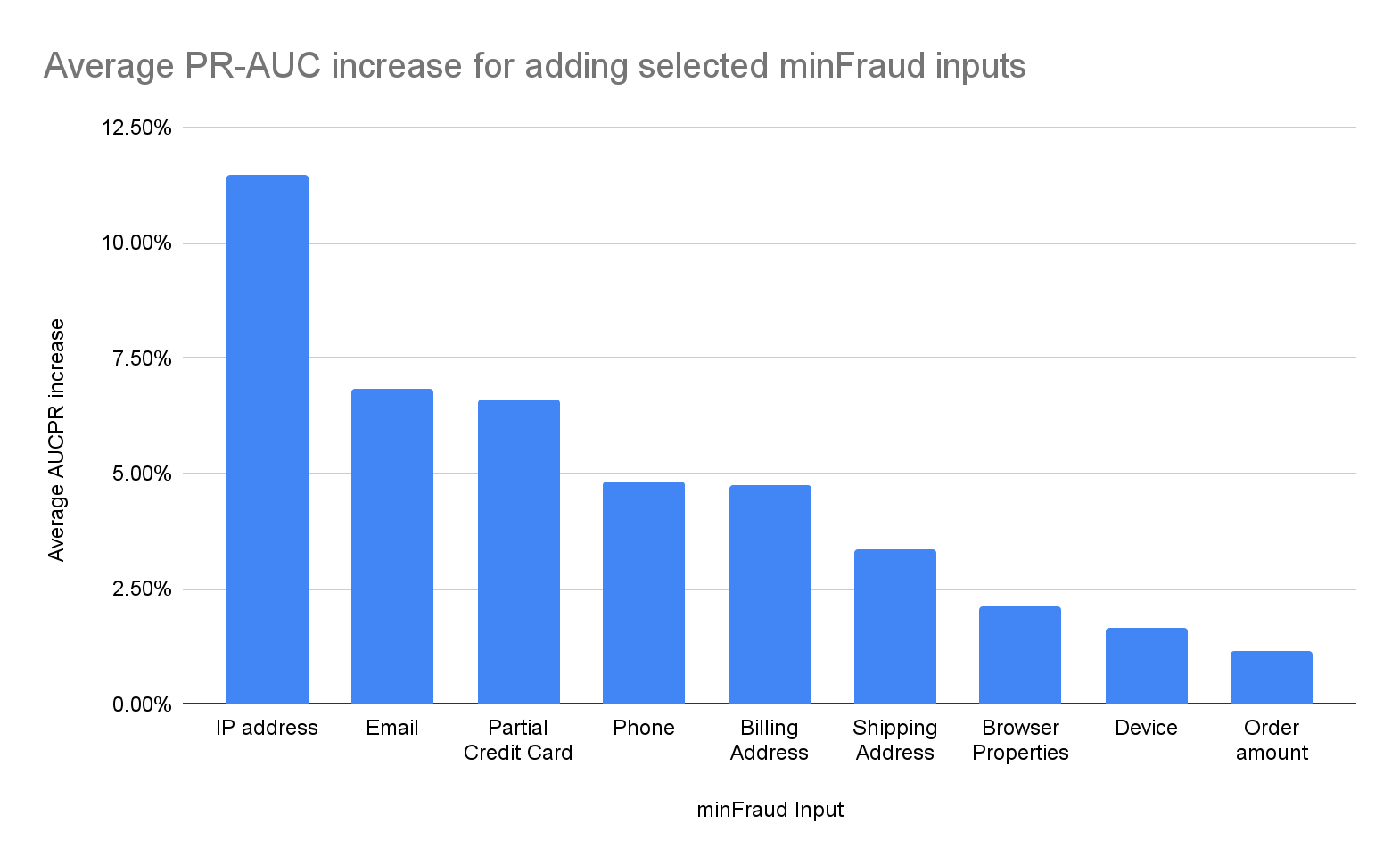Introduction
Powered by evolving machine learning models and one of the largest global fraud detection networks, minFraud helps assess online transaction data and improve fraud detection accuracy.
The built-in flexibility of the minFraud API allows for a customizable approach to integrating robust risk scoring and data enrichment into a variety of business applications.
This flexibility, however, means that our customers sometimes pass fewer than the recommended minimum inputs for the minFraud service.
Limiting the number of inputs sent to the minFraud API limits risk score accuracy. As highlighted in our case study with crypto market leader Simplex, more inputs enrich data outputs—and increase fraud detection accuracy.
The decision to limit inputs is usually due to implementation costs, including the effort needed to ensure compliance with applicable data security and privacy regulations (which MaxMind is deeply committed to). To help provide a solution for businesses in such situations, we performed a series of tests to determine the relative value of several minFraud inputs.
We undertook this analysis to provide a clear, data-forward evaluation of how (and how much) various inputs contribute to fraud detection accuracy, helping provide more information for customers who are considering which inputs to send to the minFraud API.
Methodology
At MaxMind, we use the Precision-Recall Area Under the Curve (PR-AUC) metric to evaluate whether updates to our risk scoring models help separate fraud from legitimate transactions.
The PR-AUC is a well-known measure of the performance of a machine learning model. PR-AUC is especially useful in cases where the outcome of interest for a prediction is rare, as is the case in fraud and risk detection contexts.
The PR-AUC metric reflects a model’s ability to balance precision (how many of the positive predictions are truly positive) and recall (how many true positives were predicted as positive). See this article for further information on precision and recall.
The metric examines the confusion matrix across the full range of possible risk score thresholds. Higher PR-AUC values indicate better performance in fraud detection accuracy, i.e. distinguishing fraudulent transactions from legitimate ones.
Fraud detection accuracy: minFraud vs. GeoIP
Many of our customers choose to include our IP intelligence data in their fraud and risk management models.
In particular, it’s common for enterprises to ingest proxy/VPN/anonymizer detection signals as part of IP address assessment.
In the first part of our analysis, we benchmarked three risk indicators from MaxMind data—the Anonymous IP flag, the IP risk score, and the minFraud overall risk score—to predict chargebacks in a third-party payment fraud context.
Before we reveal the results, here are the three risk indicators in detail:
Anonymous IP flag Available in our GeoIP Anonymous IP database, the
is_anonymousboolean flag indicates whether we believe the IP address to be part of an anonymizing network, such as a proxy or VPN.IP risk score Available in the minFraud API, the IP risk score goes beyond the Anonymous IP flag to report the relative riskiness of IPs, which includes risky IPs that are not flagged as anonymous.
minFraud risk score Available in the minFraud API, the overall risk score factors in the IP risk score and also incorporates real-time dynamic checks from a wide range of input data (i.e. attributes such as email, phone number, shipping address, IIN, and billing postal code).
For each risk indicator, we assessed its ability to distinguish chargeback transactions from non-chargeback ones using PR-AUC.
Since fraud detection performance can vary significantly across businesses, we computed the average PR-AUC across our customer base. To provide a meaningful benchmark, we expressed performance relative to a random guessing model.
The final evaluation metric is the average percentage increase in PR-AUC achieved by using the risk indicator compared to random guessing:
| Risk indicator | Chargeback account averaged PR-AUC vs random guessing |
|---|---|
| is_anonymous | +43% |
| IP risk score | +125% |
| minFraud risk score | +300% |
For predicting chargeback risk, the IP risk scoring model outperforms a simple anonymizer check by about 3 times, while the multi-attribute risk scoring model outperforms IP risk scoring by over 2 times (and outperforms the anonymous flag by nearly 7 times).
Digging deeper: Analyzing the impact of specific minFraud inputs
The previous analysis demonstrated how the minFraud risk score is the most effective at chargeback fraud prevention. As previously mentioned, the minFraud risk score is determined by a wide range of data inputs.
We now proceed to investigate the relative impact of the following data inputs:
- IP address
- partial credit card (the first 6-8 digits and the last 2-4 digits)
- phone number
- billing address
- shipping address
- browser (user agent and accept language HTTP headers)
- device
- order amount
The method used is similar to our initial minFraud vs. GeoIP analysis. For each input, we compared minFraud risk score performance (measured by PR-AUC for chargebacks vs. non-chargebacks) when the input is included versus when it’s omitted.
After a transaction was scored, we removed a single input and then re-scored the transaction to measure the difference in PR-AUC. The average PR-AUC gain from including each input was calculated using the following formula:
Account-averaged-PR-AUC / Account-averaged-PR-AUC-Without-input - 1
As highlighted in the chart below, the IP address input contributed the most, followed by email address and credit card—although all of the analyzed data points had a positive impact when it came to correctly predicting chargebacks.
For the billing address input, it’s worth noting that passing the complete address is not critical as most of the value of this input comes from passing the billing city, postal code, and country.

Conclusion
As this analysis shows, more input data enhances the risk model’s context, allowing it to detect more fraud while reducing false positives.
While we recommend passing as many inputs as possible, our goal with this analysis was to curate a “must-have” list of the most important inputs for the minFraud model, especially helpful when only a limited number of inputs are passed.
That said, there are other inputs that further increase lift.
Reach out to the MaxMind support team if you’d like guidance on how to optimize your minFraud integration for your specific situation.


